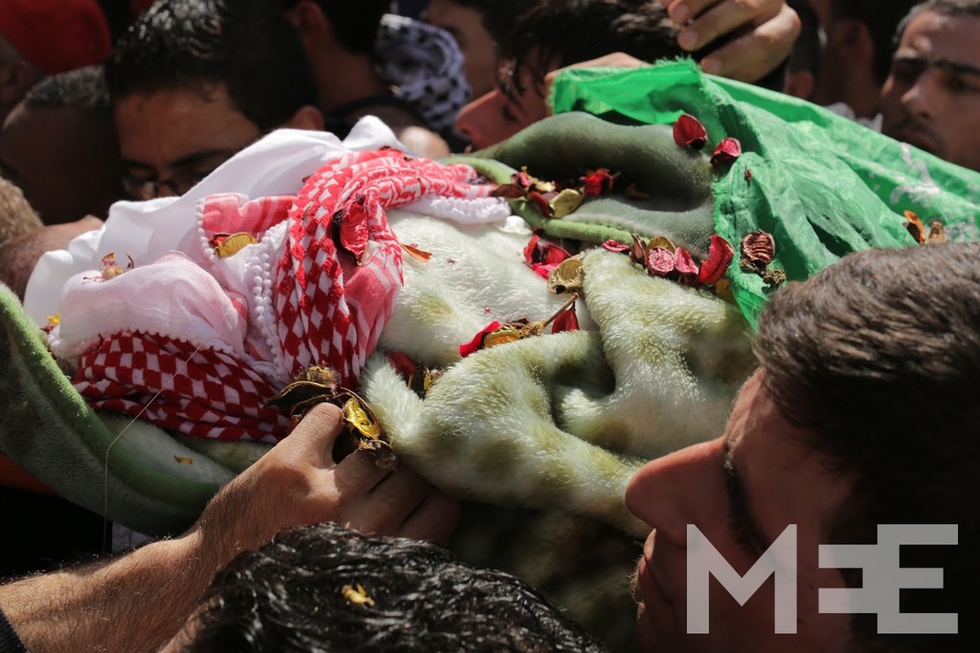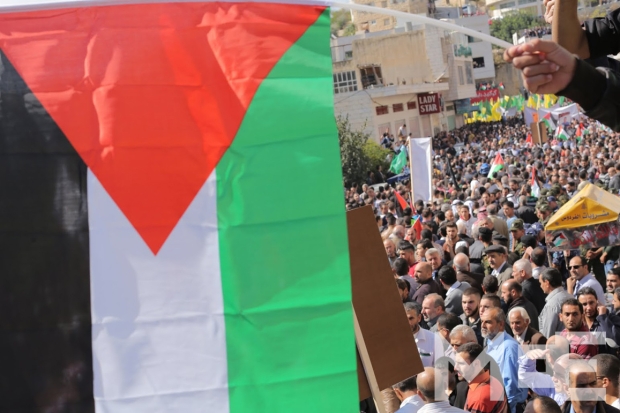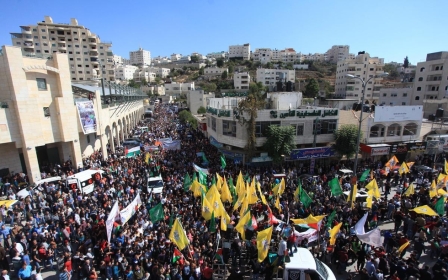VIDEO: Thousands attend funeral of slain Palestinian teenagers

HEBRON - Sharif al-Essili is among thousands of Palestinians waiting outside the Al-Hussein Mosque in Hebron for the bodies of five teenagers shot dead by Israeli forces earlier this month. Sharif looks anxious to lay his niece to rest. Islamic funeral rites require the dead to be buried in their natural state before the first sunset after the death occurred.
Sharif and the family of Bayan al-Essili have waited to bury the 17-year-old for two weeks.
"We are happy to have her back with us and to lay her to rest properly," Sharif told Middle East Eye, gripping a Palestinian flag in his fist. "But we are not sad today, we are proud of Bayan, she is a martyr and today is like a wedding for her, not a funeral."
Israeli security forces shot dead Bayan after allegedly attacking a police officer in Hebron, slicing the officer's hands before she was shot and killed. She is the third Palestinian killed on 17 October after allegedly carrying out a stabbing attack. Of the three, Bayan's attack was the only to cause injury.
Palestinians killed by Israeli forces are considered martyrs in Palestinian society, and highly respected. Funerals of said "martyrs" are politically charged and generally end in violent clashes between youth and Israeli forces.
Earlier this month, after a string of Palestinian attacks, Israel announced that the bodies of those killed during attacks would be kept by the government and buried in an undisclosed location in an attempt to discourage future attacks.
On Tuesday, Palestinians in Hebron held a large demonstrations that erupted into clashes in protest of the policy. At least 11 Palestinians who have been shot dead after alleged attempted stabbing attacks have been from the southern district.
Doctor Majid al-Jabari, the patriarch of the al-Jabari family in Hebron, said the families of those killed had been working for weeks in appeals to the Israeli government to release the remains of their dead.
Hussam al-Jabari, 17, and Bashar al-Jabari, 15, were two among the five bodies released.
"There is no law in the world that says it is okay to arrest bodies of those who have been killed, no matter what this person did," Majid said. "When someone dies their body must be given back to their families, and Israel has to respect this law in life."
After midday prayer, the bodies of Bayan, the two al-Jabari teens, as well as Dania al-Husseini, 17, and Tariq Ziyad al-Natsha, 16, were carried out of Al-Hussein Mosque to Shuhada cemetery, reserved for the bodies of those deemed to be martyrs.
Tens of thousands of Palestinians participated in the nearly two mile march, chanting political slogans and screaming “God is great!” in unison.
As the last of the teenagers were laid into their final resting place, their peers immediately left the cemetery, rushing to the city centre where Israeli soldiers predictably sat waiting at the centre’s main checkpoint. An hour into the clashes, half a dozen young Palestinians had already been shot with live bullets.
Since the start of October, at least 68 Palestinians have been shot dead by Israeli forces, a little less than half of which were killed during clashes, the others following attacks.
An Amnesty International report released earlier this week announced that the rights group, through its investigation, had found that Israeli forces were committing “extrajudicial executions” against the Palestinian population.
“There is mounting evidence that, as tensions have risen dramatically, in some cases Israeli forces appear to have ripped up the rulebook and resorted to extreme and unlawful measures,” Philip Luther, Director of the Middle East and North Africa Programme at Amnesty said. “They seem increasingly prone to using lethal force against anyone they perceive as posing a threat, without ensuring that the threat is real.”
Middle East Eye propose une couverture et une analyse indépendantes et incomparables du Moyen-Orient, de l’Afrique du Nord et d’autres régions du monde. Pour en savoir plus sur la reprise de ce contenu et les frais qui s’appliquent, veuillez remplir ce formulaire [en anglais]. Pour en savoir plus sur MEE, cliquez ici [en anglais].






